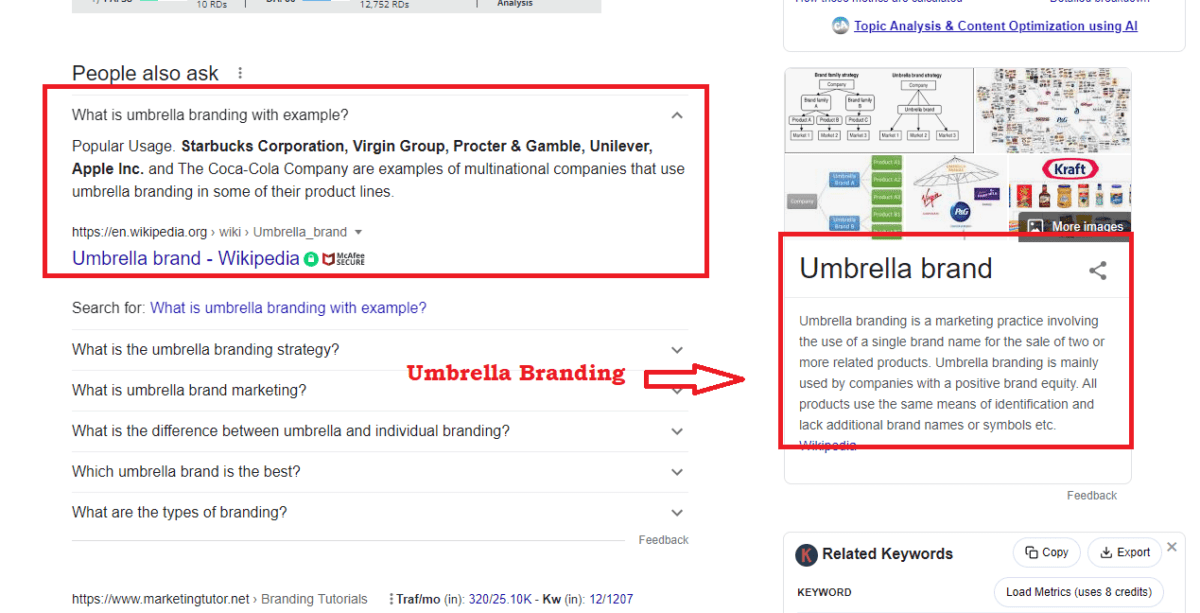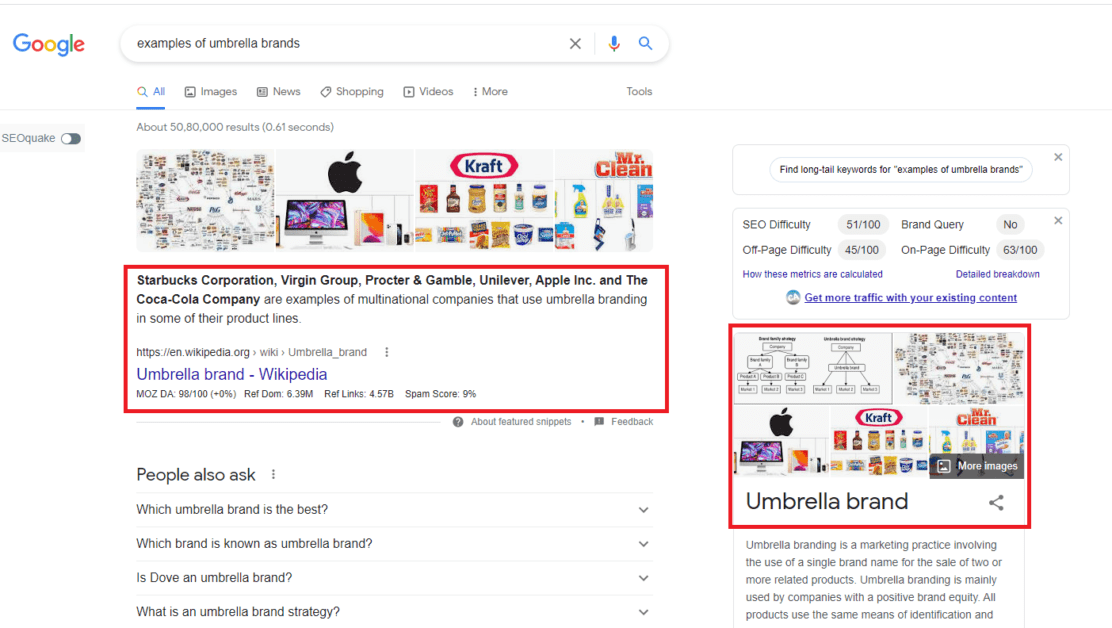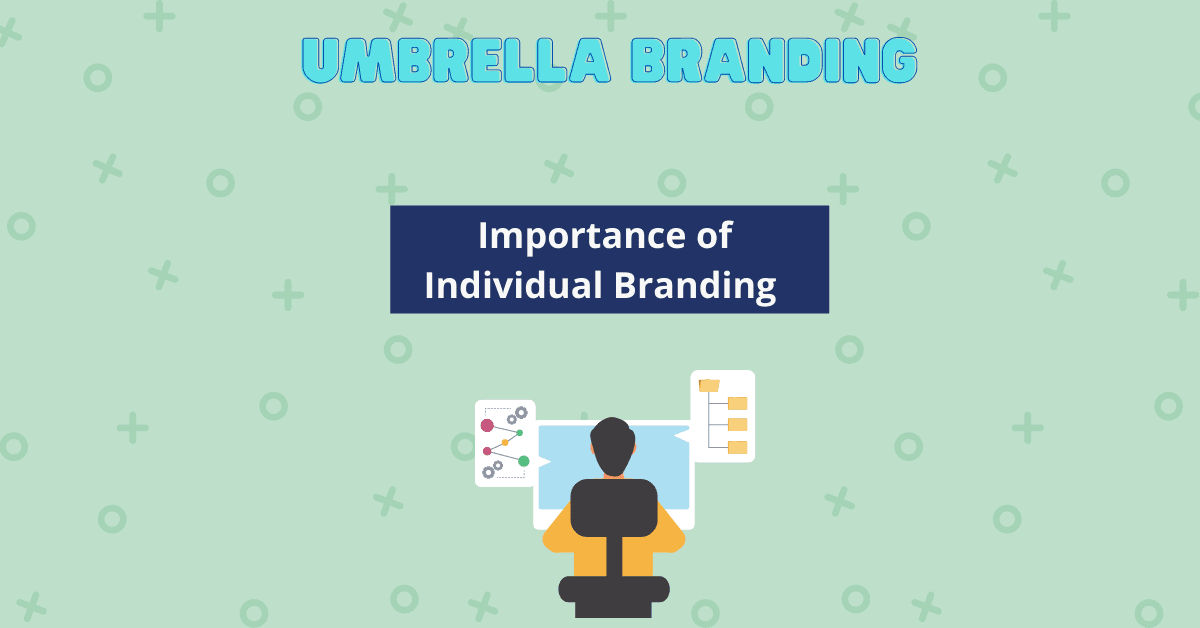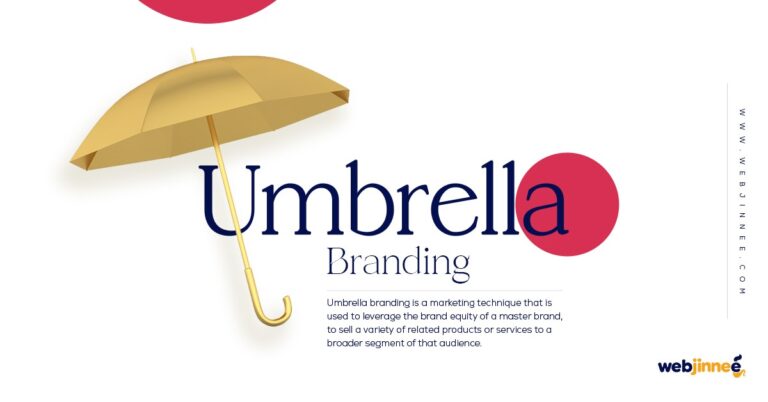Ever heard of this term, Umbrella Branding, if not then pay close attention to this blog, where I am going to discuss in detail about what is umbrella brand marketing?, and how it works, with practical examples and statements.
Table of Contents
ToggleYou will also learn about the advantages and disadvantages of this awesome marketing method Examples.
Definition of Umbrella branding
So, let’s jump straight into understanding what Umbrella Branding is. As per various marketing experts, Umbrella branding is a marketing technique that is used to leverage the brand equity of a master brand, to sell a variety of related products or services to a broader segment of that audience.
Putting it simply, the concept of umbrella branding works on a simple and effective marketing practice that involves selling or umbrella marketing many products under an already established single brand name or master brand.
You May also Like:- Secret of Writing SEO-friendly Article

What is Umbrella Branding Strategy?
Are you still figuring it out? How does it work? There is great importance of umbrella brands The enhanced reputation of the master brand or say brand equity of that master brand, allows the sub brand to go into the market with a reputation already attached and that benefits the sales and promotion of those sub brands without much effort.
So, essentially Umbrella branding strategy is a process where these sub brands are using the brand equity of these master brands to get a foot into the market and moreover help these sub-brand products or services to be easily adopted by the market, that give them a competitive advantage over other brands while advertising umbrella strategy of the brands.
You May also Like:- 249 Free Blog Submission Sites list (High DA-PA)

Now although each of these sub-brands are leveraging the master brand, they still have their own choice in terms of their messaging or their brand identity or positioning as it mostly tends to focus on the relationship between the master brand and the sub brands.
However, that obviously is one of the advantages of using this umbrella strategy and giving these sub brands the autonomy to go out and do their own thing and appeal a little bit more specificity to the audience that they’re trying to engage.
You May also Like:- 29+ Group buy SEO Tools in India (Just Rs. 149/-*)
Umbrella branding Vs Family branding
The most popular question people ask on google is How does umbrella branding differ from family branding or Umbrella branding Vs Family branding. You might have heard this before. So, Understanding what an Umbrella Brand or Family Brand.
The very simple answer is they both are the same and do not differ at all. Both umbrella branding and family branding are the same and often used interchangeably.

Examples of Umbrella branding
So it was a lot of talking, now let’s move into what is umbrella branding and understand what umbrella branding and family branding. let’s understand umbrella branding examples india.
Let’s suppose the case of the smartphone brand Xiaomi, we all know fairly about what Xiaomi is, it is one of the biggest tech brands today.
But how did it become such a giant tech brand, it is a perfect example of umbrella branding or family branding structure.
Today, Xiaomi sells everything from Xiaomi Smartphones, Xiaomi Smart TV, Xiaomi Smart devices, Xiaomi trimmers, Xiaomi Toys, Xiaomi Tools and many more lifestyle products.
Xiaomi established itself as a quality smartphone brand and then underneath the master brand it started marketing the sub brands that are sitting within the Xiaomi family brand. So, now these sub brands are leveraging the brand equity of the parent or the master brand.
So, when Xiaomi is launching any new product into the market, that product will establish itself in the market without much effort.
This will leverage the master brands equity and likewise have an edge over competitors in that segment.
Similarly there are a lot of umbrella branding examples in India that include brands like Amul, Nestle, HUL, P&G and many others. That examples shows the Importance of Umbrella Brands.
You May also Like:- How to Create a Custom Facebook Business Page URL

Advantages and Disadvantages of Umbrella Branding
However, apart from the above mentioned advantages there are certain disadvantages of Umbrella branding. So, What are the advantages and disadvantages of Umbrella branding?
We’ll, we’ve religiously covered some of the added advantages of umbrella branding now. Obviously I need to throw some light on the distinct character of the Umbrella branding.
You May also Like:- Trends You Must Follow in Digital Marketing

Umbrella Branding Advantages
- Umbrella branding helps sub brands to get into the pre-established market with an established reputation.
- It needs less or no effort in raising brand awareness for the first time and easier adoption in the market due to brand sentiment.
- Advantage from success of any other sub brand under the same umbrella.
- Saves a lot of marketing and operations costs.
Umbrella Branding Disadvantages
- Quality fluctuation is a serious issue that is one of the challenges when it comes to the umbrella branding structure.
- It needs to stick to the same consumer segment and price band and hence you cannot break the shell.
- Failure of any sub brand majorly affects the master brand and its overall reputation.
- Needs quick redressal of issues in case of any image crisis to save the entire umbrella brand.
What is Individual Branding?
Now, do you get the difference between individual branding vs umbrella branding, where in umbrella branding the new brand uses the reputation of a master brand to establish itself under its umbrella, leveraging from its brand identity and closely linking itself with the master brand’s reputation.
In Individual branding a brand establishes itself as a completely new brand with the message of bringing a unique brand identity in the market.
This helps the brand to compete against new potential brands and hence it is not closely linked to the brand it is free to find its own market and has multiple advantages to family branding.
You May also Like:- Best network marketing companies in India

What to choose between Umbrella branding and Individual branding ?
Most of us often deal with the challenge of whether there are any differences between umbrella branding and individual branding and why one should consider any of them while branding their product.
The question clearly triggers more individualistic appeal to understanding branding as a process where the ultimate goal is to become a brand and not to run a company. Do you get my point?
Branding is not the end of a product journey it is the start of a process which at the end of the day ends with good feedback from peer customers.
Now, something very fascinating is revolving around every marketer’s mind who lays new theories every time they stick around any problem and constitute a solution that can handle millions of such over time.
The problems which occur during umbrella branding or family branding is that any product’s loss of quality or poor feedback can change the brands fate and cause a serious affect to the entire brands identity.
To overcome the possibilities of the negative effects of umbrella branding, marketers often choose the style of individual branding.
Among all marketing and branding strategies, individual branding consists of the idea where a parent brand gives a new identity to the product with a unique brand name and leaves it to function independently in the market.
You May also Like:- 11 Best Email Marketing Books: You Need to Read
Need and Importance of Individual Branding
Now to make you clearly understand the concept of Individual branding, I will tell you some important reasons and functions of Individual Branding and how this type of branding has saved many brands and extended time to brands to tackle a crisis which otherwise was not possible in umbrella branding.
If we look at the case of branding 30 years ago or let’s say 50 years ago or let’s say 70 years ago, the scenario of umbrella branding was just dominating the market.
The reason was the already established master brands were driving a lot of repute from their market and new brands or individual brands were felt beaten due to lower demands.
However, the need for an individual branding strategy increases during the times of crisis.
Considering 50 years back people were not very sensitive to a brand’s overall image and trusted on the products and the competition was at a lower scale but now the game has become inflexible and people have more sentiments attached to a brand’s overall career.
You May also Like:- Top 15 Content Marketing Interview Questions and Answers

Examples of Individual Branding or Marketing
A well-known example of Individual branding or marketing is P&G (Procter and Gamble) that includes more than 65 individual brands and operates freely with unique brand recognition in the market without many of us realizing that they are part of the same company.
P&G brand’s baby care brands include All Good, Luvs, Pampers, whereas P&G Fabric Care includes Ariel, Bounce, Cheer, in a similar way it P&Gs Skin and Personal Care unit has brands like Gillette, Ivory, Native, Olay, Secret, Pantene and much more.
You May also Like:- What is Hyperlocal? A Game Changer Business Model
Key Advantages and Disadvantages of Individual Branding
Individual brand marketing strategy helps a master brand tackle several problems. It has been designed to protect an overall brand’s reputation from being disrupted and help save them from risks of crisis. Let’s study some of the major advantages of individual branding.
Advantages of Individual Branding:-
- A parent brand’s equity remains unaffected if the product fails.
- Leverages new market opportunities and explores various marketing methods.
- Individual brands can approach different methods to reach new customers.
- Individual brands can enter to sell lower category products without influencing the master brand’s image.
- Individual brands are free to position themselves in the market and drive unique brand equity.
- Individual brands can take new steps and take new risks in the market.
- Individual brands advance themselves from the increased competition in the market.
However, with all the advantages that come with individual branding there are some uncertainties that revolve around individual branding, clearly speaking the flaws and disadvantages of Individual branding have been highlighted below.
Disadvantages of Individual Branding:-
- Has a higher risk of instability in the market.
- Attracts cost to establish a new brand.
- Lack or absence of regular customers or established market
- Requires more effort to establish itself in the market.
- Involves risk of early failure.
- Lack of acknowledgment even in the long run.
- Brand equity is not as powerful to sustain a small crisis
- Individual brands often act carelessly as they are not associated with the master brand’s reputation.
So, now you are aware of the key differences between implementing an individual branding strategy or an umbrella branding strategy you know the benefits you can reap when you apply individual branding over umbrella branding and the consequences you can face for the same.
However, before implementing any of them, you can broadly discuss other brand marketing strategies with me and I can tell you what can be the best marketing strategy for your business.
You May also Like:- 11 Popular Facebook Ads Management Tools
Conclusion
So, even when an umbrella brand has terrific advantages compared to individual branding, it surely needs a lot of careful management and strict quality control of all the sub brands to ensure that no other sub brands are being affected.
This concept clearly lies in the fact of “All for one, and one for all”. I hope you now you know difference between individual and umbrella branding.


It’s the best time to make some plans for the future and it’s time to be happy. I’ve read this post and if I could I wish to suggest you some interesting things or tips. Maybe you can write next articles referring to this article. I desire to read even more things about it!
Hi,
Ofcourse, Reader’s Every suggestion is important for us…so, without hesitate share your valueable thoughts with us….
Thanks..
Keep smiling